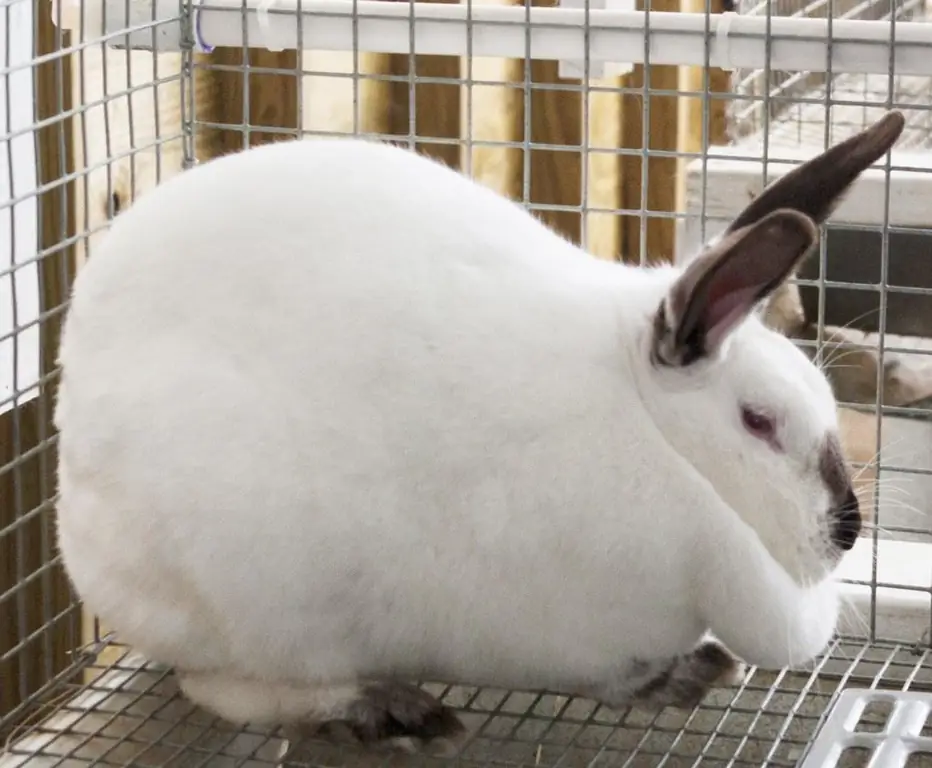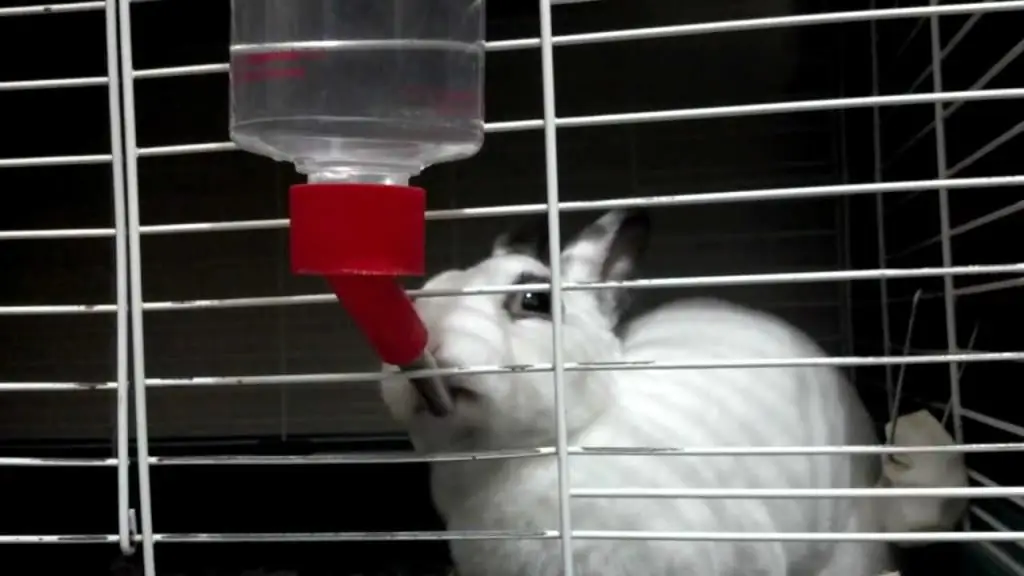2026 Author: Howard Calhoun | [email protected]. Last modified: 2025-01-24 13:10:37
A quality drinking bowl for rabbits is necessary for the normal functioning of these animals. If they do not receive enough water, they become especially vulnerable and begin to get sick often. Implemented devices are not always suitable for these animals. Therefore, it is best to make them yourself.
Requirements

A DIY rabbit drinker must meet certain conditions:
- capacity - about 1-1.5 liters of water is required per animal per day;
- closed - the vessel should not contain leftover feed, wool and rabbit excrement;
- stability - the device must be well fixed on the walls of the cage, otherwise liquid spillage is possible, which will lead to various diseases of these animals;
- convenience - the vessel must be such for both the rabbit and the owner in terms of filling it.
Photo of drinkers forbunnies posted throughout the article.
Classification of drinkers
They are divided according to the material used:
- from stainless steel;
- plastic;
- metal;
- from other materials.

By design, rabbit drinkers are classified into the following groups:
- automatic - water is supplied without human intervention when the liquid level in the vessels decreases; have a high cost, unprofitable for small farms;
- nipple - rabbit drinkers, in which the water remains clean throughout the day, does not spill, they do not turn over, however, in winter, the liquid in them freezes quickly, they are small in volume, therefore they require filling several times per day, short-lived and unreliable in terms of design, may leak near the lid;
- vacuum - can be attached to the wall with special fasteners, quite roomy, one container is enough for one rabbit for a day, however, if the liquid level is set incorrectly, they can leak;
- cups - tins, bowls, cups that can be easily turned over by animals, they easily get animal hair and excrement, therefore they are not recommended for rabbits.
Also drinkers can be divided into industrially manufactured and own production.
On large farms, automatic drinkers are preferred, while private owners are more likely to manufacture themyourself.
Creating a device is easy

The following will show you how to make your own rabbit drinker.
You can use ordinary plastic bottles for making. The drinker is made in the following steps:
- a hole is made in the center of the bottle with a knife, the same diameter as that of the rabbit's head;
- it attaches to cell walls with a wire;
- filled with 1.5 liters of water.
Thus, bottled rabbit drinkers can be made quickly and easily. They do not require special care. Of the minuses - fragility.
Creating a vacuum drinker

In this case, in addition to a plastic bottle and wire, you will need a container from which the rabbits will drink water directly, for example, a tin can.
Sequence of steps to create such a drinker:
- Water is poured into the bottle, after which it is twisted with a cap.
- Attached with wire to the wall of the cage with the neck down.
- A prepared container is installed under it, the neck should not touch its bottom a little.
- The cover is unscrewed. In this case, water will flow from the bottle into the substituted container until its level is equal to the cut of the bottle. At the moment of their coincidence, a vacuum is formed, which will keep the column of water from flowing out until the animals drink part of the liquid, as a result of which a gap is formed between the water level andbottle cut.
The container into which water enters can be mounted on a self-made groove, along which it will slide with some effort.
However, this variant of plastic bottled rabbit drinkers can get debris and dirt in them, which is detrimental to the he alth of farmed animals.
Upgraded version of the plastic drinker

This material is periodically attacked by representatives of the fauna. Therefore, it is short-lived. In order to extend its service life, carry out the following actions:
- from galvanized or stainless steel they make a box to protect a plastic bottle of 5 liters or more;
- sharp edges must be filed to avoid injury to animals.
In this case, the operating time of the bottled rabbit drinker is significantly increased.
For making it is better to take dark bottles, because in light water the water will bloom faster, which is undesirable for farmed animals.
Another version of the improved drinker is the installation of the bottle close to the surface of the container. To move water into it, you need to drill holes in the neck. In this case, it should be borne in mind that the distance from the cut to the hole should not exceed the depth of the container. It is best to make them through, placing some above and others below. You can do them crosswise. This will ensure a smooth distribution of water hammer in time at the time of bottle overturning andwill not cause it to twist or otherwise deform. With this method, you do not need to screw caps on bottles. In winter, you can even cut off the necks to make it easier to beat out the ice.
Creating a nipple drinker

To make you will need the following materials:
- silicone (sealant);
- nipple spouts;
- duct tape;
- plastic hose and bottles for 1-1, 5 l.
Nipple spouts can be purchased from the respective outlets. They can be replaced with a cut handle body with a steel bearing ball placed inside.
Production is carried out as follows:
- a hole is made in the lid of the container with a screwdriver, a heated awl or in any other available way;
- a hose is threaded into it;
- since it is difficult to calculate the diameter of the hole and make it as such at home, in most cases it turns out to be larger than required, in this case one end of the hose is wrapped with electrical tape;
- the cover at the junction with the tube is coated on both sides with sealant;
- a nipple nose is inserted into the hose or a trimming of the handle body replacing it, fixed in the same way with a sealant;
- the assembled device is placed on the outside of the cage, and the hose is threaded inward through the bars.
When creating any drinkers, you need to take into account the fact that males consume less water compared to females. The latter require more fluid during pregnancy.
Problems
Vacuum drinkers tend to freeze during winter seasons. In addition, water freezes in containers into which it flows from bottles. Therefore, when cold weather sets in, ice can be hung in the cells as a source of water. When operating nipple drinkers at this time of the year, when the spout freezes, hot water must be poured into the bottle. In addition, you can use the forced supply of liquid from a certain container using a small pump that circulates it throughout the entire water circuit in which the nipple nipples are mounted. A low-power heater can be placed in the tank to provide water supply on very cold days.
Training rabbits

These animals will not drink from nipple drinkers themselves until they realize that there is water there. While the rabbit is in the cage, the person must press the nipple with his finger. The water that remains on it must be brought first to the nose of the rabbit, and then to the mouth, so that he sniffs it and licks it off. This procedure should be carried out more than once, rabbit breeders recommend repeating it at least 3-4 times. You can stop after the owner sees that the animal began to imitate his actions by pressing the ball with his tongue.
In closing
You can make your own rabbit drinker. Plastic bottles can be used as a material for production. They can be installed in such a way that the neck does not touch the bottom or touches it. In the latter case, on the neckbottles make holes. In addition, nipple drinkers can be used. In this case, it is important to teach rabbits to take fluids on their own.
Recommended:
Can rabbits eat wheat? Features of the care and feeding of rabbits, diet, tips and tricks

Experienced rabbit breeders know that if rabbits are properly cared for, almost all diseases can be avoided. One of the keys to good he alth is good nutrition. Before you start rabbit breeding, you should carefully study what can be given to rabbits and what is strictly prohibited
Diseases of rabbits: symptoms and their treatment. Disease prevention in rabbits

Rabbit diseases can destroy most of the livestock in a matter of days. In order to provide assistance to animals in time, it is necessary to be able to determine the disease, as well as vaccinate in time, follow the rules of care
Can I give nettles to rabbits? What grass can be given to rabbits?

Herbs such as dandelion, clover, alfalfa, nettle, for rabbits are needed, first of all, for the normal functioning of the stomach. It is a source of fiber and a green storehouse of vitamins and minerals. Fiber is vital because it pushes through the hairballs that constantly enter your pet's stomach. And it also has a lot of abrasive particles that help rabbits grind their teeth in time and in a natural way
How to make a drinker for rabbits with your own hands: photos, ideas

Do-it-yourself drinkers for rabbits can have a different design. But the most popular among farmers are such containers for vacuum, cup, float and nipple. It is not difficult to make such structures on your own
Breeds of rabbits with photos and names. Giant rabbits. Meat breeds of rabbits

The rabbit was tamed by man a long time ago. This is mentioned in the written sources of ancient Roman history. From that time to the present, many new breeds have been created by rabbit breeders. Rabbits are bred to obtain dietary meat, fur, fluff. Fur products are highly durable, and the quality of the down prevails over the wool of the merino and angora goats. This article will present rabbit breeds with names and photos

